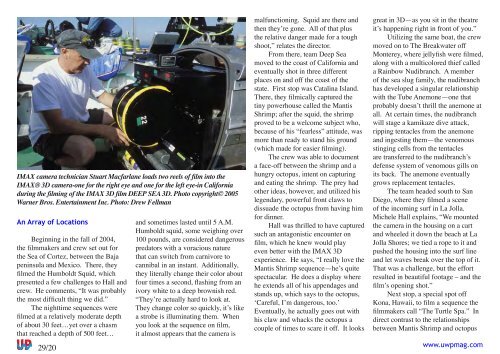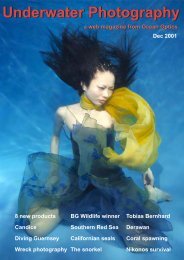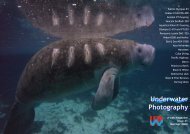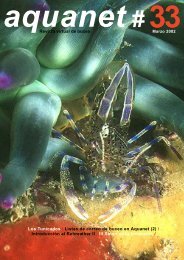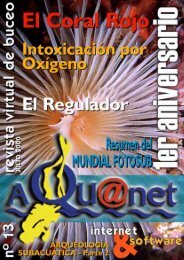Underwater Photography - SENSACIONES.org
Underwater Photography - SENSACIONES.org
Underwater Photography - SENSACIONES.org
You also want an ePaper? Increase the reach of your titles
YUMPU automatically turns print PDFs into web optimized ePapers that Google loves.
IMAX camera technician Stuart Macfarlane loads two reels of film into the<br />
IMAX® 3D camera-one for the right eye and one for the left eye-in California<br />
during the filming of the IMAX 3D film DEEP SEA 3D. Photo copyright© 2005<br />
Warner Bros. Entertainment Inc. Photo: Drew Fellman<br />
An Array of Locations<br />
Beginning in the fall of 2004,<br />
the filmmakers and crew set out for<br />
the Sea of Cortez, between the Baja<br />
peninsula and Mexico. There, they<br />
filmed the Humboldt Squid, which<br />
presented a few challenges to Hall and<br />
crew. He comments, “It was probably<br />
the most difficult thing we did.”<br />
The nighttime sequences were<br />
filmed at a relatively moderate depth<br />
of about 30 feet…yet over a chasm<br />
that reached a depth of 500 feet…<br />
and sometimes lasted until 5 A.M.<br />
Humboldt squid, some weighing over<br />
100 pounds, are considered dangerous<br />
predators with a voracious nature<br />
that can switch from carnivore to<br />
cannibal in an instant. Additionally,<br />
they literally change their color about<br />
four times a second, flashing from an<br />
ivory white to a deep brownish red.<br />
“They’re actually hard to look at.<br />
They change color so quickly, it’s like<br />
a strobe is illuminating them. When<br />
you look at the sequence on film,<br />
it almost appears that the camera is<br />
malfunctioning. Squid are there and<br />
then they’re gone. All of that plus<br />
the relative danger made for a tough<br />
shoot,” relates the director.<br />
From there, team Deep Sea<br />
moved to the coast of California and<br />
eventually shot in three different<br />
places on and off the coast of the<br />
state. First stop was Catalina Island.<br />
There, they filmically captured the<br />
tiny powerhouse called the Mantis<br />
Shrimp; after the squid, the shrimp<br />
proved to be a welcome subject who,<br />
because of his “fearless” attitude, was<br />
more than ready to stand his ground<br />
(which made for easier filming).<br />
The crew was able to document<br />
a face-off between the shrimp and a<br />
hungry octopus, intent on capturing<br />
and eating the shrimp. The prey had<br />
other ideas, however, and utilized his<br />
legendary, powerful front claws to<br />
dissuade the octopus from having him<br />
for dinner.<br />
Hall was thrilled to have captured<br />
such an antagonistic encounter on<br />
film, which he knew would play<br />
even better with the IMAX 3D<br />
experience. He says, “I really love the<br />
Mantis Shrimp sequence—he’s quite<br />
spectacular. He does a display where<br />
he extends all of his appendages and<br />
stands up, which says to the octopus,<br />
‘Careful, I’m dangerous, too.’<br />
Eventually, he actually goes out with<br />
his claw and whacks the octopus a<br />
couple of times to scare it off. It looks<br />
great in 3D—as you sit in the theatre<br />
it’s happening right in front of you.”<br />
Utilizing the same boat, the crew<br />
moved on to The Breakwater off<br />
Monterey, where jellyfish were filmed,<br />
along with a multicolored thief called<br />
a Rainbow Nudibranch. A member<br />
of the sea slug family, the nudibranch<br />
has developed a singular relationship<br />
with the Tube Anemone—one that<br />
probably doesn’t thrill the anemone at<br />
all. At certain times, the nudibranch<br />
will stage a kamikaze dive attack,<br />
ripping tentacles from the anemone<br />
and ingesting them—the venomous<br />
stinging cells from the tentacles<br />
are transferred to the nudibranch’s<br />
defense system of venomous gills on<br />
its back. The anemone eventually<br />
grows replacement tentacles.<br />
The team headed south to San<br />
Diego, where they filmed a scene<br />
of the incoming surf in La Jolla.<br />
Michele Hall explains, “We mounted<br />
the camera in the housing on a cart<br />
and wheeled it down the beach at La<br />
Jolla Shores; we tied a rope to it and<br />
pushed the housing into the surf line<br />
and let waves break over the top of it.<br />
That was a challenge, but the effort<br />
resulted in beautiful footage – and the<br />
film’s opening shot.”<br />
Next stop, a special spot off<br />
Kona, Hawaii, to film a sequence the<br />
filmmakers call “The Turtle Spa.” In<br />
direct contrast to the relationships<br />
between Mantis Shrimp and octopus<br />
29/20 www.uwpmag.com


